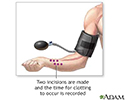Bleeding time
Bleeding time is a medical test that measures how fast small blood vessels in the skin stop bleeding.
Because it is difficult to perform correctly, it is rarely used today.
How the Test is Performed
A blood pressure cuff is inflated around your upper arm. While the cuff is on your arm, your health care provider makes two small cuts on the lower arm using a special device. They are just deep enough to cause a tiny amount of bleeding.
The blood pressure cuff is immediately deflated. Blotting paper is touched to the cuts every 30 seconds until the bleeding stops. The provider records the time it takes for the cuts to stop bleeding.
How to Prepare for the Test
Certain medicines can change blood test results.
- Tell your provider about all the medicines you take.
- Your provider will tell you if you need to temporarily stop taking any medicines before you have this test. This may include dextran and aspirin or other nonsteroidal anti-inflammatory drugs (NSAIDs).
- Do not stop or change your medicines without talking to your provider first.
How the Test will Feel
The tiny cuts are very shallow, and can be made with a small lancet or with a special instrument with a spring that makes a very shallow cut. Most people say it feels like a skin scratch.
Why the Test is Performed
This test helps diagnose bleeding problems.
Bleeding problems
Bleeding disorders are a group of conditions in which there is a problem with the body's blood clotting process. These disorders can lead to heavy a...
Normal Results
Bleeding normally stops within 1 to 9 minutes.
What Abnormal Results Mean
Longer-than-normal bleeding time may be due to:
- Blood vessel defect
-
Platelet aggregation defect (clumping problem with platelets, which are parts of the blood that helps the blood clot)
Platelet aggregation defect
The platelet aggregation blood test checks how well platelets, a part of blood, clump together and cause blood to clot.
Read Article Now Book Mark Article -
Thrombocytopenia (low platelet count)
Thrombocytopenia
Thrombocytopenia means there is an abnormally low amount of platelets. Platelets are parts of the blood that help blood to clot. This condition is ...
Read Article Now Book Mark Article
Risks
There is a very slight risk of infection where the skin is cut.
References
Pai M, Moffat KA. Laboratory evaluation of hemostatic and thrombotic disorders. In: Hoffman R, Benz EJ, Silberstein LE, et al, eds. Hematology: Basic Principles and Practice. 8th ed. Philadelphia, PA: Elsevier; 2023:chap 127.
Rao AK, Songdej N, Di Paola JA. Platelet disorders and von Willebrand disease. In: McPherson RA, Pincus MR, eds. Henry's Clinical Diagnosis and Management by Laboratory Methods. 24th ed. Philadelphia, PA: Elsevier; 2022:chap 41.
Schafer AI. Approach to the patient with bleeding or thrombosis. In: Goldman L, Cooney KA, eds. Goldman-Cecil Medicine. 27th ed. Philadelphia, PA: Elsevier; 2024:chap 157.
-
Blood clot test - illustration
The bleeding time test is used to evaluate how well a person's blood is clotting. The test evaluates how long it takes the vessels cut to constrict and how long it takes for platelets in the blood to seal off the hole. Blood vessel defects, platelet function defects, along with many other conditions can result in prolonged bleeding time.
Blood clot test
illustration
-
Blood clot test - illustration
The bleeding time test is used to evaluate how well a person's blood is clotting. The test evaluates how long it takes the vessels cut to constrict and how long it takes for platelets in the blood to seal off the hole. Blood vessel defects, platelet function defects, along with many other conditions can result in prolonged bleeding time.
Blood clot test
illustration
Review Date: 2/3/2025
Reviewed By: Warren Brenner, MD, Oncologist, Lynn Cancer Institute, Boca Raton, FL. Review provided by VeriMed Healthcare Network. Also reviewed by David C. Dugdale, MD, Medical Director, Brenda Conaway, Editorial Director, and the A.D.A.M. Editorial team.


